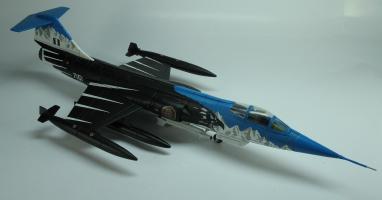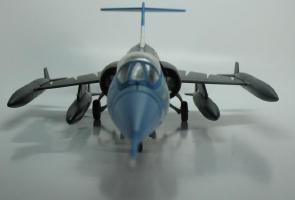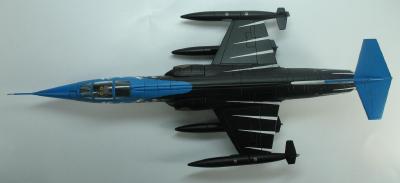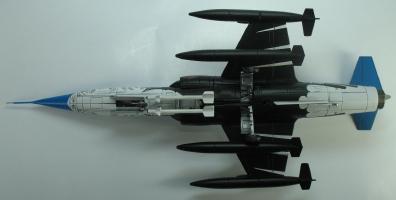Hobby Master Archive
Air Power Jets 1/72
F-104
Olympus Greek Hellenic Air Force F-104G model plane
Hobby Master 1/72 Air Power Series HA1003 F-104G “Olympus” Hellenic (Greece) Air Force
History of the F-104G in Hellenic (Greek) Air Force service Greece originally received 45 F-104Gs and 6 TF-104Gs under the US MAP (Military Assistance Program) in 1964. In 1972 used planes started to be bought with nine more F- 104Gs and one TF-104G aircraft acquired from Spain, ten more F-104Gs from the Netherlands in 1982. The largest purchase came when a further thirty eight F-104Gs, twenty two RF-104Gs and twenty TF-104Gs were bought from West Germany. The West German planes were acquired mainly between 1981 - 1988. With one hundred second hand planes some were mothballed and used as spare parts. Originally flown with just the natural metal finish they eventually were given a camouflage 3 color paint scheme on top of olive drab / dark green / sand, the bottom was a light grey. These planes were flown by two Greek squadrons, the first being 335 Mira from the 114 Pterix (Wing) based at Tanagra AB. The second was 336 Mira, also based at Tanagra AB at the time. December 21st 1966 saw 336 Mira move to a new base at 116 Pterix at Araxos AB. The F-104 went on in the Hellenic Air Force service until 1993 when 336 “Olympus” Mira Diokseos Bombardismou (Fighter-Bomber Squadron) was deactivated March 31.
HA1003 F-104 “Olympus” Sleek, slender and supersonic, the F-104 was one plane that stood out in a crowd. Deserving of its eye-catching form, the Greek Air Force painted this spectacular scenic scheme to commemorate the “Final Flight” of the F-104 in Greek service. Hobby Master has once again managed to flawlessly duplicate the original painting. From the dart like nose to the high T-tail as well as the razor sharp leading edges of the wings, complete with tip tanks and drop tanks, the artists at Hobby Master have captured every color, line and curve. Don’t miss the count down on this rocket, it is sure to be a big seller.
Background on the F-104G The F-104G was known as the Super Starfighter, with the G standing for Germany, because they were among the first foreign orders for the Lockheed plane and they placed the largest order. Depending on the source there were between 1,122 and 1,700 G models built under license by 4 European companies, Canadair and Lockheed. The G was a multi-role all weather single seat fighter-bomber with a new upward firing ejection seat, a strengthened fuselage and wings, increased internal fuel capacity, new improved full length flaps added to the wings leading edge for better combat maneuvering, a larger vertical fin, a new radar system with air-air and air-ground modes, inertial navigation that made the F-104G the first production fighter to receive this new equipment, new infrared sight, an additional hard-point under each wing, improved weapons capability now was 4,000 lbs and beefed up landing gear and larger wheels to carry all the added weight of the improvements. The larger gear and wheels made it necessary to create a bulge in the fuselage to accommodate them. The G even received a new engine, though it didn’t deliver any more power it was a much more reliable engine. The G was considered the best version of the F-104. The U.S. only accepted 296 Starfighters before it was considered to be less than satisfactory. With modifications the F-104 was sold to many NATO countries, using what was to become known as “Deal of the Century”. This brought about an extremely large income for Lockheed and caused a huge political controversy in Europe. The general feeling was that the countries bought the F-104 only after they were brow beaten by U.S. political powers and a considerable amount of funds were given as bribes to the people in European governments responsible for aircraft procurement. There was a huge outcry in Germany and the minister of defence was forced to resign. Prince Bernhard of the Netherlands was also linked to the scandal and later admitted taking over 1 million dollars US. Later in the 1970s it was revealed that Lockheed had in deed been involved in political bribery in an effort to save the company that was going through hard times and close to bankruptcy. Furthermore, after many F-104 crashes and deaths the general consensus was the Starfighter was an unsafe plane. What might have been the defining answer to the question of “was the Starfighter a safe plane” Oberleutnant von Hassel, the son of the new German minister of defence was killed in an F-104G. The last Starfighter flew in military service until 2004 when Italy finally retired them.
Specifications for the F-104G: Engine: One General Electric J79-GE-11A turbojet, 10,000 lb.s.t. dry and 15,600 lb.s.t. with afterburning.
Performance: Maximum speed 1146 mph at 50,000 feet, 1328 mph at 35,000 feet. Stalling speed 216 mph. Initial climb rate 48,000 feet per minute. Service ceiling 50,000 feet, and absolute ceiling 90,000 feet. Normal range 1080 miles. Maximum range with four drop-tanks was 1630 miles.
Fuel: Internal fuel capacity was 897 US gallons, and maximum fuel capacity with two wingtip tanks and two under-wing tanks was 1784 US gallons.
Dimensions: Wingspan 21 feet 9 inches, length 54 feet 8 inches, height 13 feet 6 inches, wing area 196.1 square feet.
Weights: 13,996 pounds empty, 20,640 pounds combat, 29,038 pounds maximum takeoff.
Armament: One 20-mm M61A1 cannon with 725 rounds in the fuselage, plus up to four AIM-9B Sidewinder infrared homing air-to-air missiles. Up to 4000 pounds of external ordnance (bombs, rockets, napalm, drop tanks) could be carried on under-wing and under-fuselage hard-points.
THESE ARE PRE-PRODUCTION PICTURES NOT THE RETAIL VERSION
| Added to archive | 2015-11-19 |
| Last modified | 2015-11-19 |






